In November and December, Disney is changing the way FASTPASS+ (FP+) is being distributed at Epcot. Previously, those staying at Disney hotels could make three reservations–any three for a given park (no parkhopping concept is baked in, at least not yet). But now they are being told they can only book ONE reservation for the tier 1 rides at Epcot, and the other two reservations must be tier 2 rides. Translation: the E-Ticket rides are being limited.
Tier one: (Choose ONE):
- Illuminations: Reflections of Earth (Only select dates available)
- Maelstrom
- Meet the Disney Pals at the Epcot Character Spot
- Soarin’
- Test Track presented by Chevrolet
Tier two: (Choose TWO):
- Captain EO
- Journey into Imagination with Figment
- Living with the Land
- Mission Space
- Spaceship Earth
- The Seas with Nemo and Friends
- Turtle Talk with Crush
I’m not surprised. Anyone could see that visitors would never spend their three reservations on Captain EO, Turtle Talk, and Living with the Land when there was also Soarin’, Test Track, and Maelstrom available. If Disney wanted to spread out the crowds to the smaller attractions, this was inevitable. By hook or by crook, the crowds WILL be dispersed.
I’m more convinced than ever that unlike Limited Time Magic, they are working with a master plan here for FP+ and not just making it up as they go. There’s too much money at stake. And events are unfolding just like many have predicted from the beginning, just by looking at what infrastructure is being built and using logic to figure out how Disney will make money from the whole thing.
Make no mistake. It’s about money and always has been. You don’t invest $1 billion on a whim. It has to be explained and justified to the Board of Directors (those folks who can fire the CEO), and with this much money being dumped in, you can bet there was one heck of a PowerPoint justification for the spending. There has to be return on investment (ROI) for anything in a modern publicly-traded company, and a big deal like will have definite ROI built in and expected.
I’ve still not seen those numbers or that presentation, but I bet we can inch our way toward some tentative numbers (with the big caveat that we are in the land of invention here, so please take with a grain of salt and chime in to suggest improvements in the comments).
Let’s start with the cost. Some rumors suggest the true cost of the entire MyMagic+ program is closer to $1.2 billion (note: I previously wrote an article that used a $3 billion price tag, which I have been told was an incorrect rumored cost, so we’re returning to $1.2 billion). It’s an intangible asset, so we can bet Disney will amortize the cost of the program; let’s say they do so over ten years. Simplifying from the amortization tables (depreciation, inflation, etc) just for convenience, let’s simply pretend they want to pay $1.2 billion over ten years, meaning each year must earn an extra $120 million for the system to pay for itself. Dividing by 365 days, that means every day must bring an additional $329,000 in profit, on top of what they already make. Let’s see if we can’t come up with that money:
- Increased spending from more “free” time away from lines. Rasulo said something about this to institutional investors in 2013, but this logic was also applied to the original FastPass program in the mid-1990s, and anecdotally (as well as logically) it doesn’t seem like they really harvest much money from this strategy. It’s certainly possible that they can tweak this new system to make it EVEN MORE scheduled from home (what if they gave you ten reservations per day?) so it’s always conceivable that they WILL create a system whereby you browse shops and eat food between reservations, and do nothing else. But for now, I’m keeping this profit per day at a minimum level: $1,000.
- Sales from MagicBand merchandise. They sell “BandIts” and “CoverBands” and all sort of stuff to tack onto your MagicBand. I doubt I’ll buy any of this myself, but let’s assume there is SOME profit per day from this: $1,000.
- Guest Recovery cost savings and full utilization of E-Tickets at night. In the present world, even the world of paper FastPasses, many of the big rides have empty lines at the end of the night. This under-utilized capacity means opportunity cost. If some of the crowds during the peak hours could be convinced to visit Space Mountain late at night instead. that shortens the line for everyone during the day and everyone wins. FP+ provides that enticement. Unlike the free and readily available paper FP reservations, FP+ reservations are limited and precious, and a late-night Space Mtn reservation is unlikely to be ignored. So Disney will finally have spread out the crowds across the day, even more than the paper FP system did (and it went a big way toward doing that already). The resultant lowered lines during the day means fewer angry visitors and thus fewer giveaways of food, merchandise, and other goodies to make them happy (the aforementioned “Guest Recovery”) and also happier customers. Happier customers come back next year, tell their neighbors to come to WDW also, and in general bring additional money to the resort simply by being happy and coming back more often. Disney can quantify this, but lacking their data I’m just guessing. Additional daily profit: $2,000.
- Additional marginal sales from the Big Data elements of MM+ Don’t underestimate Big Data. Because their new system will integrate guest attendance patterns, spending patterns, ride reservation patterns, character meeting patterns, and so on, they will essentially be able to customize special offers just for you. In the era of print-on-demand books, just-in-time inventory, and 3D printing, it’s not hard to imagine ever more niche-oriented merchandising. So if their Big Data identifies 10,000 families who love the Haunted Mansion more than anything else and visit Chip and Dale more than all other characters, I wonder if those families will get an email offer for some custom-produced Doom Buggy figures with Chip and Dale in them? There are few limits to what they will know and what they will be able to offer us. A tour of the HM graveyard for $300/person, after hours? Sure! More Test Track merchandise, with a special offer mailed just to you for a discount? Sure! $2 off on the carved turkey sandwich at Be Our Guest? Don’t mind if I do! It’s hard to estimate the daily boost in profit, but it won’t be negligible. Let’s go with $3,000.
- Beating Universal. This is a squishy category and not directly a money-maker, but Disney knows that Uni is now a major competitor and must be beaten. If Disney can get the journalists talking about their innovations (a stress-free fully reserved theme park day) rather than talking about Uni’s new rides, Disney will win in multiple ways. They want to be seen in the popular consciousness as the place to go, not Universal, so they also need the new system to impress the visitors directly, who will tell their neighbors when they get back from vacation. More people will go to Disney than Universal (or at least the current outflow will be staunched) and that means more spending on hotels, more food sales, more merch sales, and more ticket sales. If we assume they divert 500 people per day from Universal to Disney, that’s probably $100/per person per day, yielding additional daily profit of $50,000
- Upcharge FP+ reservations. Disney has never breathed a word about this, but I will be shocked if they don’t eventually offer to sell you more reservations (probably open to day-visitors, off-site hotel visitors, and Disney hotel guests). Want five reservations per day instead of three? Pay $10/person and you can have it! We frequent visitors might scoff, but imagine you were visiting from far away. Like when you someday visit Shanghai Disneyland, and you’ve only got one day. The online system lets you reserve 3 E-Tickets (because you’re staying at their hotel) but you want to buy two more. Time is more important than money (to some extent), so $10/person doesn’t seem too much to swallow to give you a really great day. Could they sell a single upcharge reservation to 1/10 of the families/parties visiting? Let’s assume there are 20,000 people per park (this is VERY conservative), so one-tenth of the population is 2,000 persons per park, or 8,000 persons per day at WDW. If we guess $5/reservation, the additional daily profit is $40,000. If they allow triple that amount of people to buy more reservations, it still wouldn’t be a big dent in the in-park attendance, but would move you to $120,000 per day. And if each of those people was buying TWO additional reservations, as in our Shanghai example above, we’re up to $240,000/day. But let’s stay with the more-conservative $40,000 for now.
- Reduce operating costs. The big perk of staying at a Disney hotel right now is extra magic hours (EMH). With the creation of FP+ (so far just showing up at Disney hotels), there is a new perk for sleeping in the mouse’s rooms. That means they are possibly going to look at removing EMH as a perk (wouldn’t you, if you were in their shoes?) If they did that, they would save a lot of money, which could be shoved around the accounting tables to function essentially the same as additional daily profit. They have EMH essentially one hour per day, all week long. I don’t know what it takes to run the Magic Kingdom, but let’s guess 3,500 workers at a time. Each hour of labor costs the company more than just wages to the worker; they have to factor in health insurance, perks and all that other stuff. The “loaded rate” ten years ago was $15/hour, which I’m sure has gone up, but let’s just use $15/hour for now. 3,500 workers costing $15 for a single EMH hour gives the company a daily savings of $52,000.
- Fully book the Disney hotels. Most hotel operators would kill for Disney’s current occupancy rate, but Disney would obviously like to be at 100% all the time. Let’s say Disney hotels are currently at 90% occupancy when viewed across the whole year (I think it’s in the high 80s, but we’ll estimate conservatively as always). If they keep FP+ to just Disney hotels, as they have done so far, that will drive more people to stay with Disney. Or they could give MORE reservations to Disney hotels than to people who stay offsite. Or they could play with the Tier allotments–could Grand Floridian visitors someday get three Tier1 reservations and two Tier2 reservations, versus a different mixture for Disney budget hotels and a third mixture for off-site hotel visitors? This holiday season, the Swan and Dolphin hotels are joining the FP+ rollout, the first non-Disney hotels to do so (they are, however, on property). We should not underestimate the power of full occupancy. There are 30,400 hotel rooms on property at WDW. If Disney can go from 90% occupancy (27,360 rooms) to 100% occupancy (30,400 rooms), that’s an additional 3,000 rooms sold every day. Guessing wildly at the overall average profit of each hotel room (let’s use $125/room), this is $375,000 each and every day additional profit, just by filling the last vacant rooms.
The hotel rooms alone make enough money to offset the cost of MM+ and FP+, which surprised me. Everything else was just gravy. The total additional profit of all my estimates is $524,000 per day, and we only needed $329,000 per day to pay for the amortized cost of FP+. Keep in mind, I tried to use conservation estimates in the categories above, so if my guessing was wrong, Disney could easily yield multiples of the dollar values discussed here. My numbers are essentially “worst case scenario” results for FP+ marginal profit, and the best-case could be a runaway success, profit-wise. No wonder the Board approved it.
Do you know the term “freemium”? It refers to products that are free to try and even free to use in limited ways, but then you pay a premium if you want to unlock all the features. A great many smartphone and tablet apps work this way. It occurs to me that some of the ideas discussed above share commonalities with the freemium model. You get the “base” experience of WDW for free (well, not for free, but with your gate admission ticket). If you want more, you pay for more, by staying at a Disney hotel, or by buying additional per-day reservations (remember: both of those are speculation right now).
What’s really going on is a process of mimicking the Disney Cruise Line (DCL) model. The DCL experience has been universally cheered at an optimal vacation experience, and with good reason. What’s a DCL trip look like? First, it’s all-inclusive. You pay one (inflated) price at the beginning, but then you get a ton of things for free: unlimited buffets, evening shows, kids’ programming, and so on. Even sodas are free on a Disney ship.
But is it really all-inclusive? You pay extra if you want to rent a cabana on the beach. You pay for alcoholic beverages. You have to pay if you want a shore excursion to Mayan ruins. There’s an upcharge if you want to eat at the premium restaurant on board. The more you think about it, the more you’ll agree it’s really NOT all-inclusive… but it does a great job of MASQUERADING as an all-inclusive experience.
The theme parks have had the appearance of being all-inclusive since the early 1980s, when they switched from the ticket book system to an all-day passport. With that switch, the rich people couldn’t ride the E-Ticket experiences any more than the working-class visitors. Everyone got the same chance to ride the rides as much as they want. But here, too, there are cracks. Are the theme parks of 1992 or 2013 truly populist, egalitarian places? People with more money can eat at better restaurants and buy better souvenirs. They can purchase VIP tours that use FastPass queues without reservations or tickets, so it’s essentially backdoor treatment.
The modern Disney theme park has already been inching toward a DCL-type vacation where many elements are fixed in place before you show up. You’ve long been able to make restaurant reservations. There are length of stay free soda refills, and paid-up-front meal plans so the planning is done before your vacation and now you can just relax while on your trip. And the addition of ride reservations will only enhance that comparison to DCL and the appearance of all-inclusiveness. The rides will be akin to the ship activities and entertainment (included in the cost) and only the reservations as applied to the E-ticket rides will be like the shore excursions, available for additional cost. The move to a freemium model, if it comes, will bring the theme parks closer to the DCL system of “masqueraded equality.” Everyone gets the same base experience, but if you want to pay more, you can.
As always, I’m interested in your opinions, corrections, and additions to my list of ROI streams of revenue. Feel free to let us know as well your reaction to the idea of a “freemium” Walt Disney World.
WDW Clicks
WDW Clicks is my new video podcast, a slideshow of images from the parks narrated to provide additional detail and context.
In this week’s episode (direct link), we look at several things:
- new Brown Derby Lounge (quick service at the Brown Derby, with the full menu available)
- new soda flavors at Club Cool
- meet and greet for the Frozen characters
- new costumes for the France pavilion
- revised meet-and-greet room for Pooh and friends at UK pavilion, themed to Christopher Robin’s room (opened last month)
- Construction on the final hydroponics room at Living with the Land
- even more tree-clearing at the entrance to the Land
- Disney Springs construction
- Starbucks at Downtown Disney construction
- Marketplace Snacks new menu
- Osborne Lights installation progress
- Glow with the Show ears display on Sunset Blvd
- new props in queue of Backlot Tram Tour
- merch updates
Anna and Elsa debut in Norway
After an initial test in DHS, the characters from Frozen have started appearances in the shop in Norway (the former “final” shop on your way out from the ride). You will find more photos of this meet-and-greet in the WDW Clicks video, but I wanted to spend some time here in print pondering the throughput of this experience.
We got in line at 2:20 and were told that we were joining the 3:00 line. The switchbacks set up in the general Norway walkway was the entire queue (all outdoors), and I then saw there was a cutoff point. Those at the front of the line inched forward as they were admitted to the meet-and-greet, but those of us at the back were held by a rope, so that’s how they knew who belonged to which group. It made sense; this way, the characters could get a break once per hour.
But it left me wondering: is this a typical through-put for a meet and greet? I estimated that perhaps 35 (maybe 50 at most) people were able to see the Frozen princesses (well: princess and queen) per hour. 35 per hour seems like incredibly low capacity to me, especially given the 7 Cast Members working this experience. But I don’t have a lot of experience with tracking this. I do recall Merida having very long lines next to the castle (also in the hot sun) so maybe this is typical. We heard a lot from folks who were unhappy about the long lines for Merida.
And it’s certainly possible that processes here are still being worked out. Maybe they’ll move to a system where they have two sets of princesses and can just walk the current set offstage, to be replaced by a new set with no waiting. Then they wouldn’t have to cut the line “by hour” any more; that would probably help.
That said, I’m glad I got to see this now, before the movie comes out and the crowds descend. It’s only slated to be here until January from what I hear, which may make the crowds decide to prioritize this experience even more.
Let us know in the comments what you think–will they have a situation on their hands like they did with Merida?

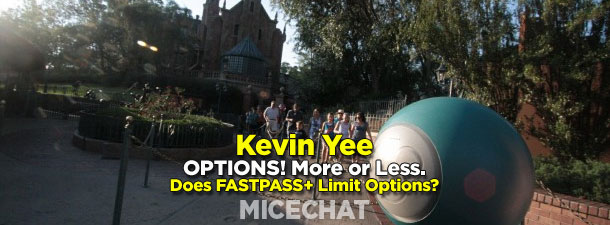
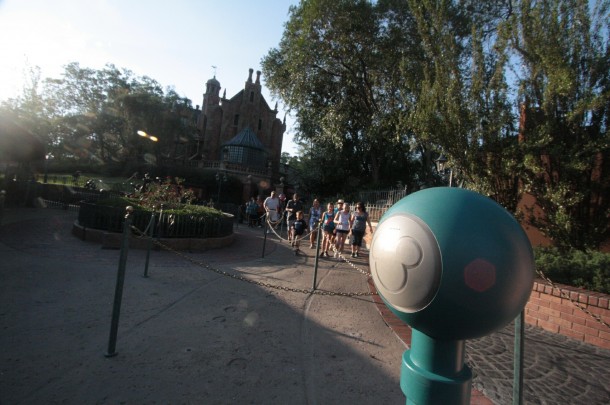
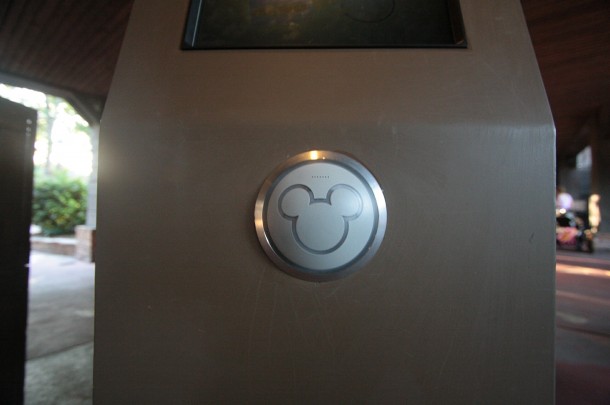

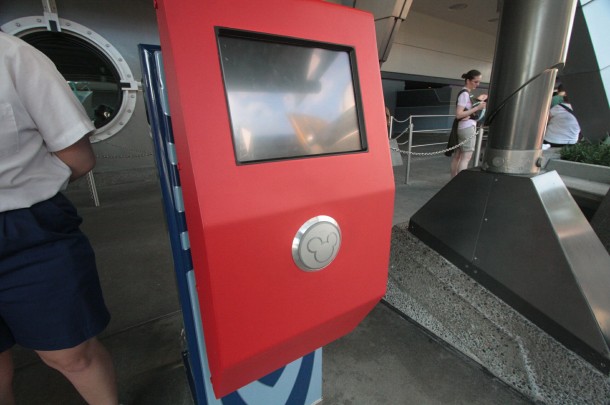
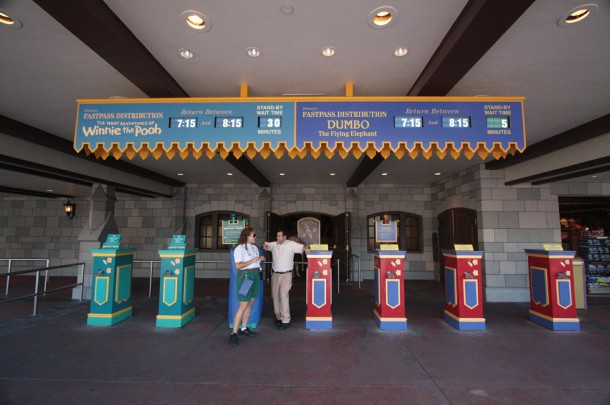
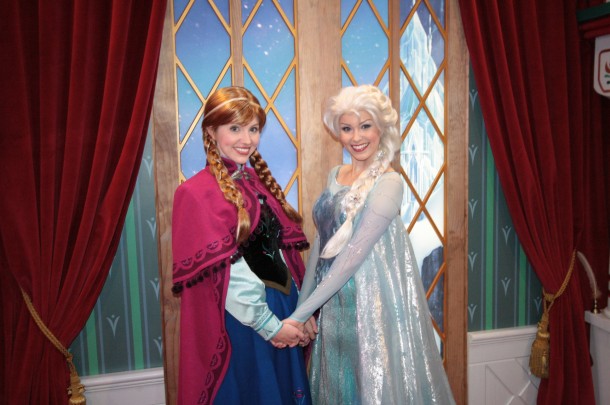

You must be logged in to post a comment.